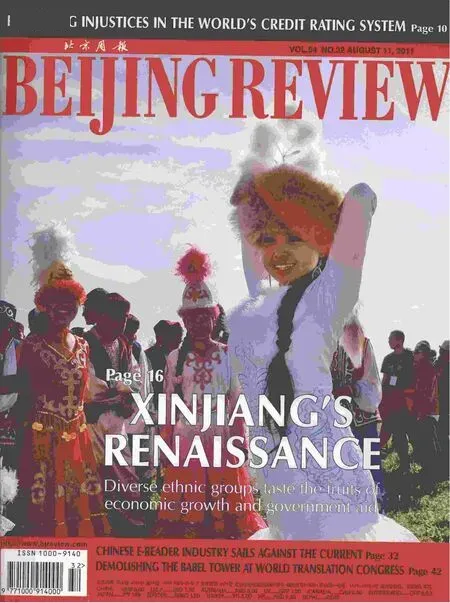More Help, More Prosperity Enhanced assistance program proves effective in its first-year operation
2011-12-24ByYUANYUAN
By YUAN YUAN
More Help, More Prosperity Enhanced assistance program proves effective in its first-year operation
By YUAN YUAN
Xinjiang Uygur Autonomous Region, previously known as a vast, remote and underdeveloped land in China’s northwest, has become one of the country’s hottest investment destinations.
In July, Beijing said it would invest another 7.26 billion yuan ($1.13 billion) in municipal infrastructure construction and other livelihood programs in Hotan in south Xinjiang.
Earlier, Shanghai, the country’s largest business hub, decided to set aside some 1.55 billion yuan ($240.87 million) in funds this year to fund the construction of more than 100 projects in Kashgar in west Xinjiang.
These projects will have a bearing on the livelihood of local people, ranging from housing, health care and medical treatment, education, to scientific and technological popularization, said Shanghai offcials.
Beijing and Shanghai are among 19 better developed provinces and municipalities assigned by the Central Government to help with the development of Xinjiang. Over the next 10 years, these provinces and municipalities will provide funds, technology and management expertise for their partners in Xinjiang.
“The ‘pairing assistance’ program is not new in Xinjiang,” said Jurat Imin, Deputy Secretary of the Hotan Prefecture Committee of the Communist Party of China. “It has been running in Xinjiang since 1996. While in the past no amount was specifed for how much money aid providers should invest, today there are defned objectives and more transparent criteria.”
The new “pairing assistance” program was launched in March 2010, with the number of recipient cities and towns in Xinjiang increasing to 82 from 56 under the previous program. The Central Government also set clear targets for provinces and municipalities offering aid.
The enhanced program is modeled on the recovery plan adopted in southwest China’s Sichuan Province following the 2008 Wenchuan earthquake.
The direct economic loss from the earthquake was almost 980 billion yuan ($152.29 billion), far beyond Sichuan’s economic capacity. In response, the State Council partnered each severely affected county with one of 19 wealthier provinces or municipalities in the eastern region. Until 2012, the involved provinces and municipalities are required to donate at least 1 percent of their annual fscal revenue toward reconstruction projects.
The assistance program in Xinjiang involves the same 19 provinces or municipalities.
“All the 19 provinces and municipalities are required to contribute 0.3 to 0.6 percent of their fscal revenue from 2011 to 2020 to support Xinjiang’s development,” Jurat said. “The investment in recipient regions in Xinjiang will increase 8 percent a year throughout the first fve years of the program.”
Provinces and municipalities with greater financial muscle, such as Guangdong and Beijing, are assigned to help the least developed areas such as Hotan and Kashgar. The provinces in northeast China, Heilongjiang, Jilin and Liaoning, have been paired up with Tacheng and Altay in the northern part of Xinjiang because they have similar climatic conditions.
Jurat said allocating aid to county-level regions could help providers gain an edge in targeting the problems that constrain the development of those regions, so their aid would be more effective. “That’s a lesson learned from the Sichuan reconstruction,” he said.
Between May 27 and 29, a meeting was held in Beijing to push forward the “pairing assistance” program.
Speaking before the meeting, President Hu Jintao said the “pairing assistance” program had been running well in the past year with marked improvements already achieved in the region’s infrastructure development and social stability. He expressed the hope Xinjiang would fulfill the goals of the program and emerge as a prosperous society by 2020.
“The region’s development and stability are at a critical moment,” said Vice Premier Li Keqiang at the meeting. Li called for intensified efforts to establish an effective mechanism for providing technological, managerial and financial support, with improvements in housing, employment and education as priorities.
“The region still lags behind other provinces and faces challenges in capital, technology, management and other areas,”said Ashar Turson, President of Xinjiang University of Finance and Economics. “So achieving fast growth without external assistance is almost impossible. This new ‘pairing assistance” program could drive Xinjiang’s annual fscal revenue up by as much as 8 billion yuan ($1.24 billion) to 10 billion yuan ($1.55 billion), which is 25 percent of the current total revenue.”
“The ultimate goal the Central Government has set for aid-providing provinces and municipalities is to improve the living standards of Xinjiang residents,” Jurat said.
